Literature Review: The Impact of IoT in Healthcare Systems
VerifiedAdded on 2023/02/01
|7
|1823
|61
Literature Review
AI Summary
This literature review explores the application of the Internet of Things (IoT) in healthcare, examining its impact on various aspects of the industry. The review begins by defining the concept of IoT and its evolution, highlighting its integration into everyday devices to improve connectivity and communication. It then delves into the use of IoT in healthcare, including smart homes, transportation, and the medical field, with a focus on healthcare applications, such as patient monitoring, smart beds, and the creation of m-health systems. The review emphasizes the effectiveness of IoT in revolutionizing healthcare, increasing the longevity of life, and improving medical outcomes. It categorizes the medical devices that fall under the internet of things into wearable external devices, implanted medical devices, and stationary medical devices. The document also addresses the literature gap in the field, particularly the need for an emergency notification system. The review concludes by summarizing the benefits of IoT in healthcare, highlighting the potential for improved patient care and medical outcomes, and suggesting further research to address the identified gaps, such as the development of emergency notification systems to save millions of lives.
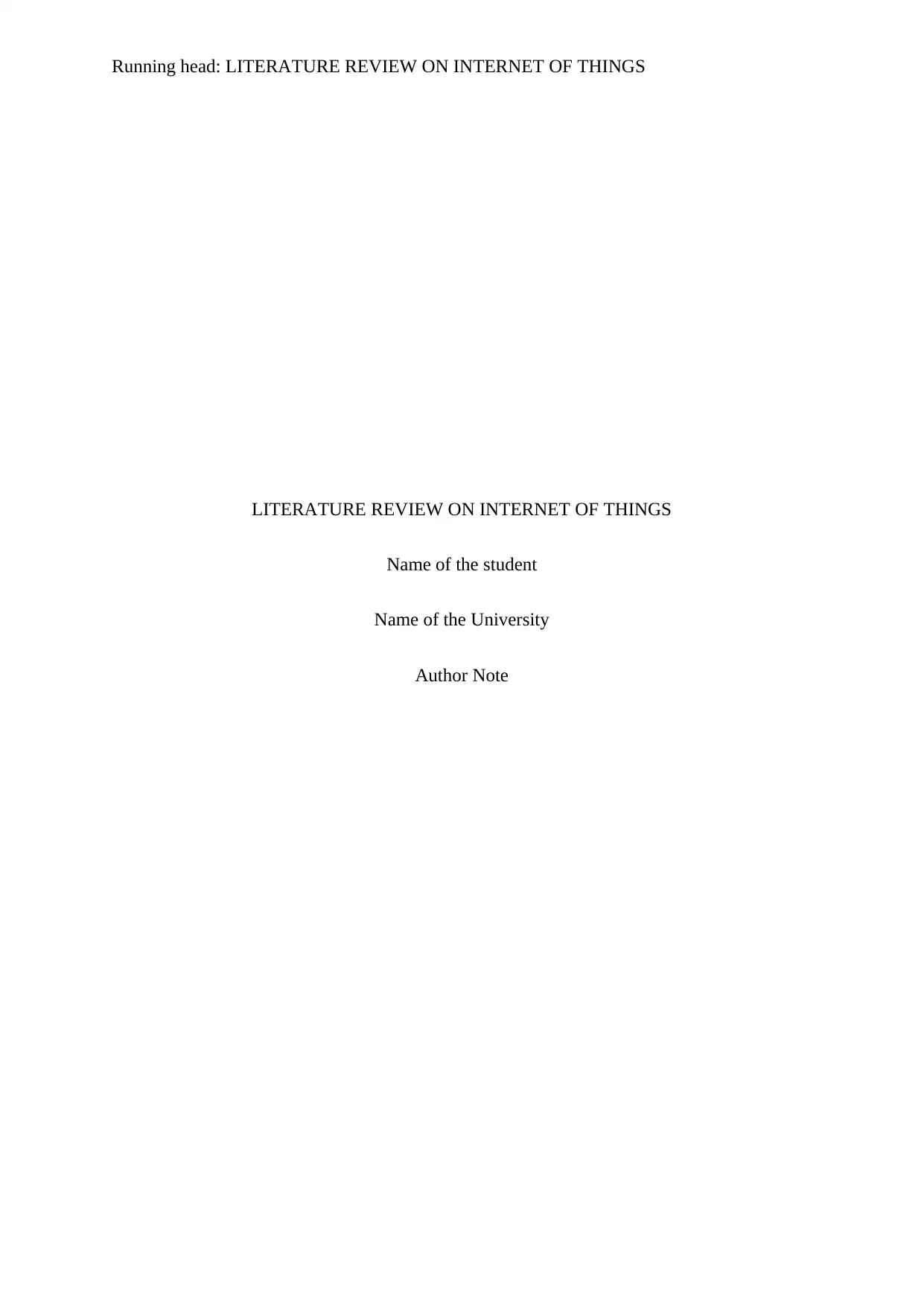
Running head: LITERATURE REVIEW ON INTERNET OF THINGS
LITERATURE REVIEW ON INTERNET OF THINGS
Name of the student
Name of the University
Author Note
LITERATURE REVIEW ON INTERNET OF THINGS
Name of the student
Name of the University
Author Note
Paraphrase This Document
Need a fresh take? Get an instant paraphrase of this document with our AI Paraphraser
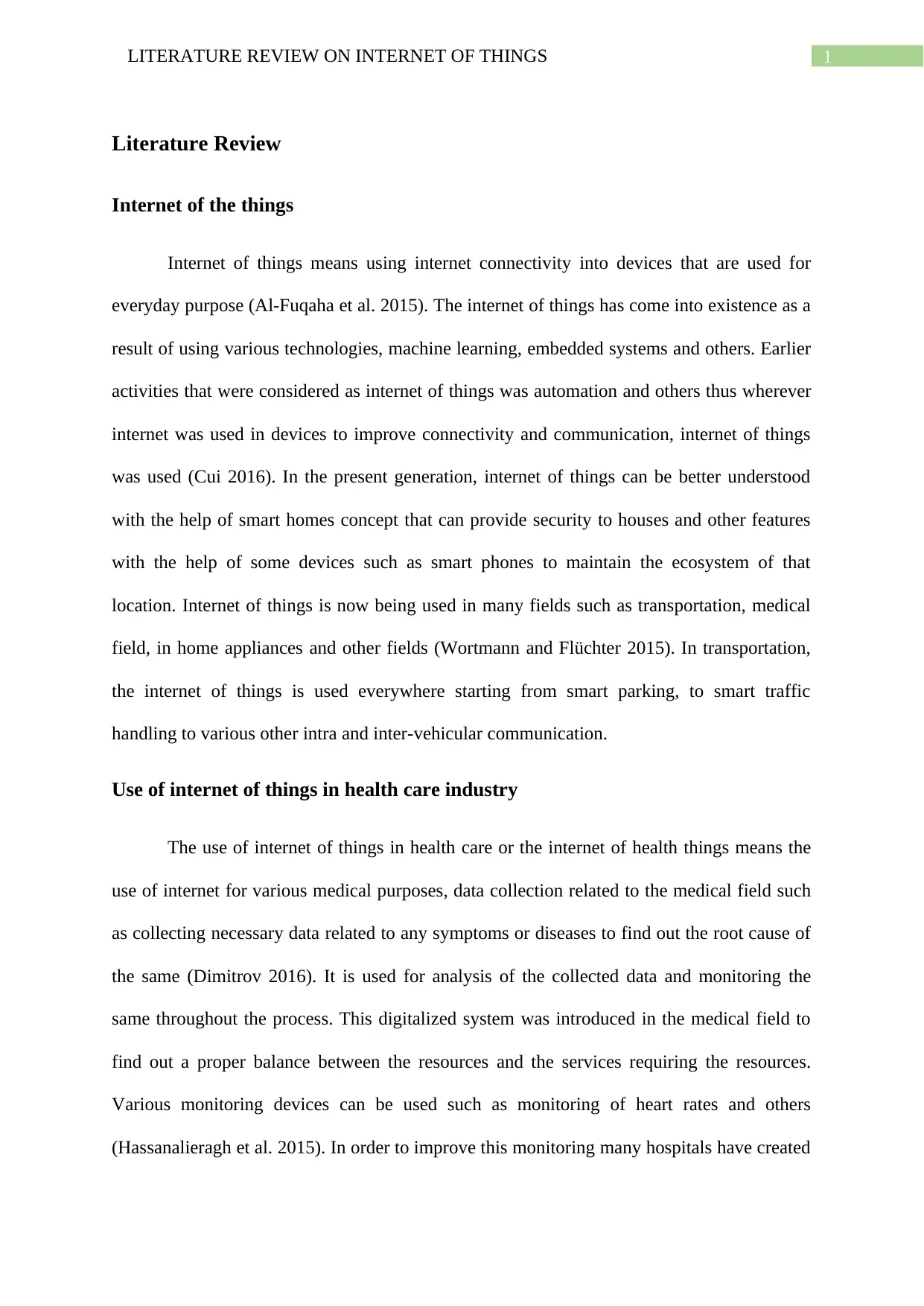
1LITERATURE REVIEW ON INTERNET OF THINGS
Literature Review
Internet of the things
Internet of things means using internet connectivity into devices that are used for
everyday purpose (Al-Fuqaha et al. 2015). The internet of things has come into existence as a
result of using various technologies, machine learning, embedded systems and others. Earlier
activities that were considered as internet of things was automation and others thus wherever
internet was used in devices to improve connectivity and communication, internet of things
was used (Cui 2016). In the present generation, internet of things can be better understood
with the help of smart homes concept that can provide security to houses and other features
with the help of some devices such as smart phones to maintain the ecosystem of that
location. Internet of things is now being used in many fields such as transportation, medical
field, in home appliances and other fields (Wortmann and Flüchter 2015). In transportation,
the internet of things is used everywhere starting from smart parking, to smart traffic
handling to various other intra and inter-vehicular communication.
Use of internet of things in health care industry
The use of internet of things in health care or the internet of health things means the
use of internet for various medical purposes, data collection related to the medical field such
as collecting necessary data related to any symptoms or diseases to find out the root cause of
the same (Dimitrov 2016). It is used for analysis of the collected data and monitoring the
same throughout the process. This digitalized system was introduced in the medical field to
find out a proper balance between the resources and the services requiring the resources.
Various monitoring devices can be used such as monitoring of heart rates and others
(Hassanalieragh et al. 2015). In order to improve this monitoring many hospitals have created
Literature Review
Internet of the things
Internet of things means using internet connectivity into devices that are used for
everyday purpose (Al-Fuqaha et al. 2015). The internet of things has come into existence as a
result of using various technologies, machine learning, embedded systems and others. Earlier
activities that were considered as internet of things was automation and others thus wherever
internet was used in devices to improve connectivity and communication, internet of things
was used (Cui 2016). In the present generation, internet of things can be better understood
with the help of smart homes concept that can provide security to houses and other features
with the help of some devices such as smart phones to maintain the ecosystem of that
location. Internet of things is now being used in many fields such as transportation, medical
field, in home appliances and other fields (Wortmann and Flüchter 2015). In transportation,
the internet of things is used everywhere starting from smart parking, to smart traffic
handling to various other intra and inter-vehicular communication.
Use of internet of things in health care industry
The use of internet of things in health care or the internet of health things means the
use of internet for various medical purposes, data collection related to the medical field such
as collecting necessary data related to any symptoms or diseases to find out the root cause of
the same (Dimitrov 2016). It is used for analysis of the collected data and monitoring the
same throughout the process. This digitalized system was introduced in the medical field to
find out a proper balance between the resources and the services requiring the resources.
Various monitoring devices can be used such as monitoring of heart rates and others
(Hassanalieragh et al. 2015). In order to improve this monitoring many hospitals have created
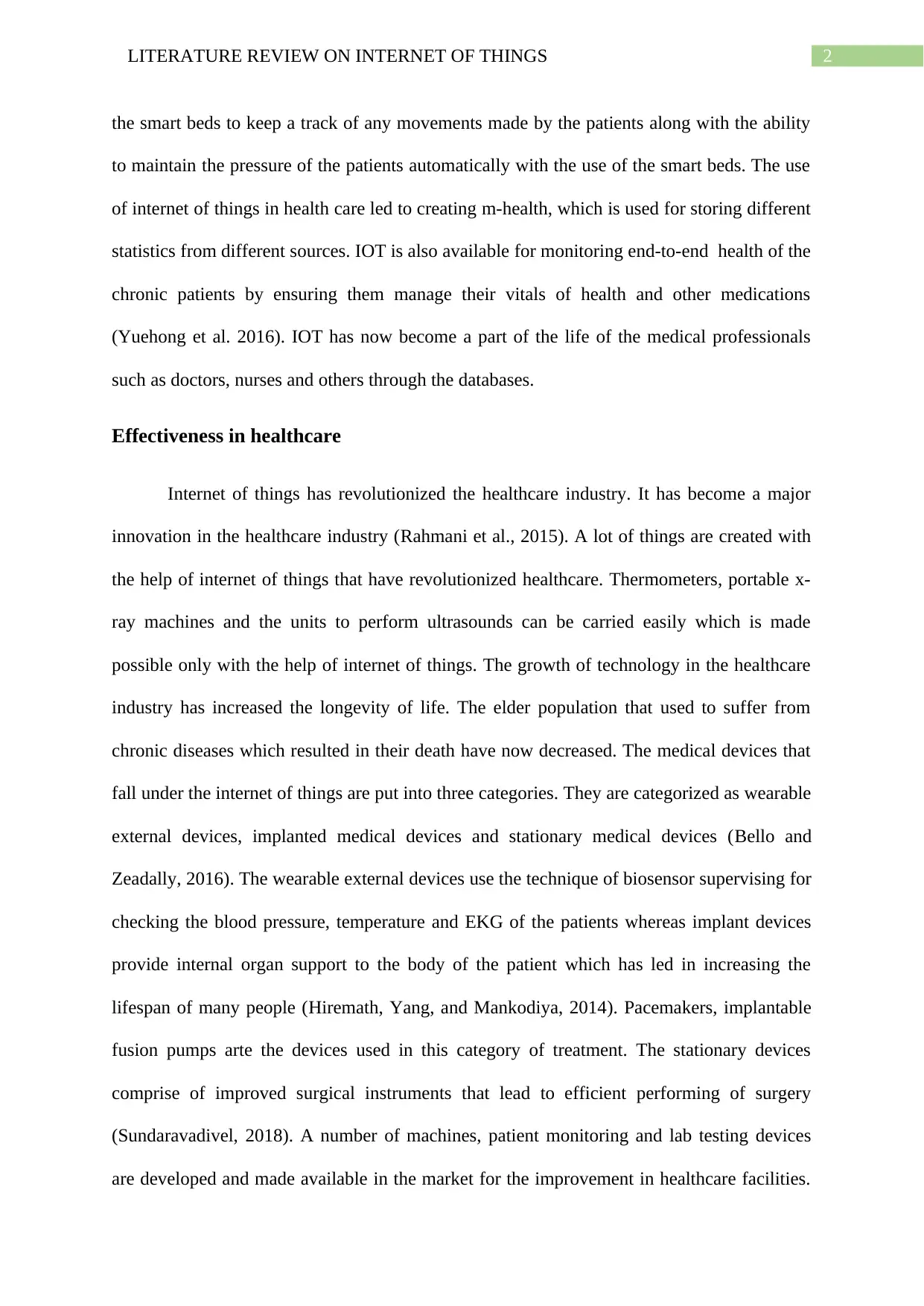
2LITERATURE REVIEW ON INTERNET OF THINGS
the smart beds to keep a track of any movements made by the patients along with the ability
to maintain the pressure of the patients automatically with the use of the smart beds. The use
of internet of things in health care led to creating m-health, which is used for storing different
statistics from different sources. IOT is also available for monitoring end-to-end health of the
chronic patients by ensuring them manage their vitals of health and other medications
(Yuehong et al. 2016). IOT has now become a part of the life of the medical professionals
such as doctors, nurses and others through the databases.
Effectiveness in healthcare
Internet of things has revolutionized the healthcare industry. It has become a major
innovation in the healthcare industry (Rahmani et al., 2015). A lot of things are created with
the help of internet of things that have revolutionized healthcare. Thermometers, portable x-
ray machines and the units to perform ultrasounds can be carried easily which is made
possible only with the help of internet of things. The growth of technology in the healthcare
industry has increased the longevity of life. The elder population that used to suffer from
chronic diseases which resulted in their death have now decreased. The medical devices that
fall under the internet of things are put into three categories. They are categorized as wearable
external devices, implanted medical devices and stationary medical devices (Bello and
Zeadally, 2016). The wearable external devices use the technique of biosensor supervising for
checking the blood pressure, temperature and EKG of the patients whereas implant devices
provide internal organ support to the body of the patient which has led in increasing the
lifespan of many people (Hiremath, Yang, and Mankodiya, 2014). Pacemakers, implantable
fusion pumps arte the devices used in this category of treatment. The stationary devices
comprise of improved surgical instruments that lead to efficient performing of surgery
(Sundaravadivel, 2018). A number of machines, patient monitoring and lab testing devices
are developed and made available in the market for the improvement in healthcare facilities.
the smart beds to keep a track of any movements made by the patients along with the ability
to maintain the pressure of the patients automatically with the use of the smart beds. The use
of internet of things in health care led to creating m-health, which is used for storing different
statistics from different sources. IOT is also available for monitoring end-to-end health of the
chronic patients by ensuring them manage their vitals of health and other medications
(Yuehong et al. 2016). IOT has now become a part of the life of the medical professionals
such as doctors, nurses and others through the databases.
Effectiveness in healthcare
Internet of things has revolutionized the healthcare industry. It has become a major
innovation in the healthcare industry (Rahmani et al., 2015). A lot of things are created with
the help of internet of things that have revolutionized healthcare. Thermometers, portable x-
ray machines and the units to perform ultrasounds can be carried easily which is made
possible only with the help of internet of things. The growth of technology in the healthcare
industry has increased the longevity of life. The elder population that used to suffer from
chronic diseases which resulted in their death have now decreased. The medical devices that
fall under the internet of things are put into three categories. They are categorized as wearable
external devices, implanted medical devices and stationary medical devices (Bello and
Zeadally, 2016). The wearable external devices use the technique of biosensor supervising for
checking the blood pressure, temperature and EKG of the patients whereas implant devices
provide internal organ support to the body of the patient which has led in increasing the
lifespan of many people (Hiremath, Yang, and Mankodiya, 2014). Pacemakers, implantable
fusion pumps arte the devices used in this category of treatment. The stationary devices
comprise of improved surgical instruments that lead to efficient performing of surgery
(Sundaravadivel, 2018). A number of machines, patient monitoring and lab testing devices
are developed and made available in the market for the improvement in healthcare facilities.
⊘ This is a preview!⊘
Do you want full access?
Subscribe today to unlock all pages.

Trusted by 1+ million students worldwide

3LITERATURE REVIEW ON INTERNET OF THINGS
Various medical facilities that have accelerated the healthcare process are medical
applications that make the availability and delivery of medicine fast and feasible for the
individuals. The advent of smart techniques in the healthcare regimes have helped patients to
avail medical assistance easily. The techniques of monitoring the patient health history,
gathering of medical data with the help of automatic devices is helpful for the health industry.
Automated treatment devices have carved a niche in the healthcare industry due to their
utilization in the industry ((Rahmani et al., 2018). Real time location facilities are helpful in
tracking the locating and tracking the supply of materials in the hospitals. The evolution of
these devices have led to cost efficiency in the process of treatment, the experience of the
patients in the process of healthcare has become better. The management of the medical
facilities that are availed in the process have become easy to supervise and that has led to
raise the quality standard of the devices used. The materials that are used in the were earlier
wasted due to lack of supervision are now reduced. The biggest achievement of using internet
of things in healthcare is that the process of maintaining data related to the patients has
become easy which has led to improved medical outcomes (Islam et al., 2015).
Literature gap
Many researches have been done in the field of internet of health things such as
research regarding the use of smart beds, research on proper monitoring of the health care
process and others. However, these researches have not focused on the notification system for
emergencies. This is important in case of patient suffering from chronic diseases and for old
aged patients. These patients are not always able to approach the doctors or the nurse at the
time of emergency so if such a notification system is introduced, these patients will be
benefitted.
Various medical facilities that have accelerated the healthcare process are medical
applications that make the availability and delivery of medicine fast and feasible for the
individuals. The advent of smart techniques in the healthcare regimes have helped patients to
avail medical assistance easily. The techniques of monitoring the patient health history,
gathering of medical data with the help of automatic devices is helpful for the health industry.
Automated treatment devices have carved a niche in the healthcare industry due to their
utilization in the industry ((Rahmani et al., 2018). Real time location facilities are helpful in
tracking the locating and tracking the supply of materials in the hospitals. The evolution of
these devices have led to cost efficiency in the process of treatment, the experience of the
patients in the process of healthcare has become better. The management of the medical
facilities that are availed in the process have become easy to supervise and that has led to
raise the quality standard of the devices used. The materials that are used in the were earlier
wasted due to lack of supervision are now reduced. The biggest achievement of using internet
of things in healthcare is that the process of maintaining data related to the patients has
become easy which has led to improved medical outcomes (Islam et al., 2015).
Literature gap
Many researches have been done in the field of internet of health things such as
research regarding the use of smart beds, research on proper monitoring of the health care
process and others. However, these researches have not focused on the notification system for
emergencies. This is important in case of patient suffering from chronic diseases and for old
aged patients. These patients are not always able to approach the doctors or the nurse at the
time of emergency so if such a notification system is introduced, these patients will be
benefitted.
Paraphrase This Document
Need a fresh take? Get an instant paraphrase of this document with our AI Paraphraser
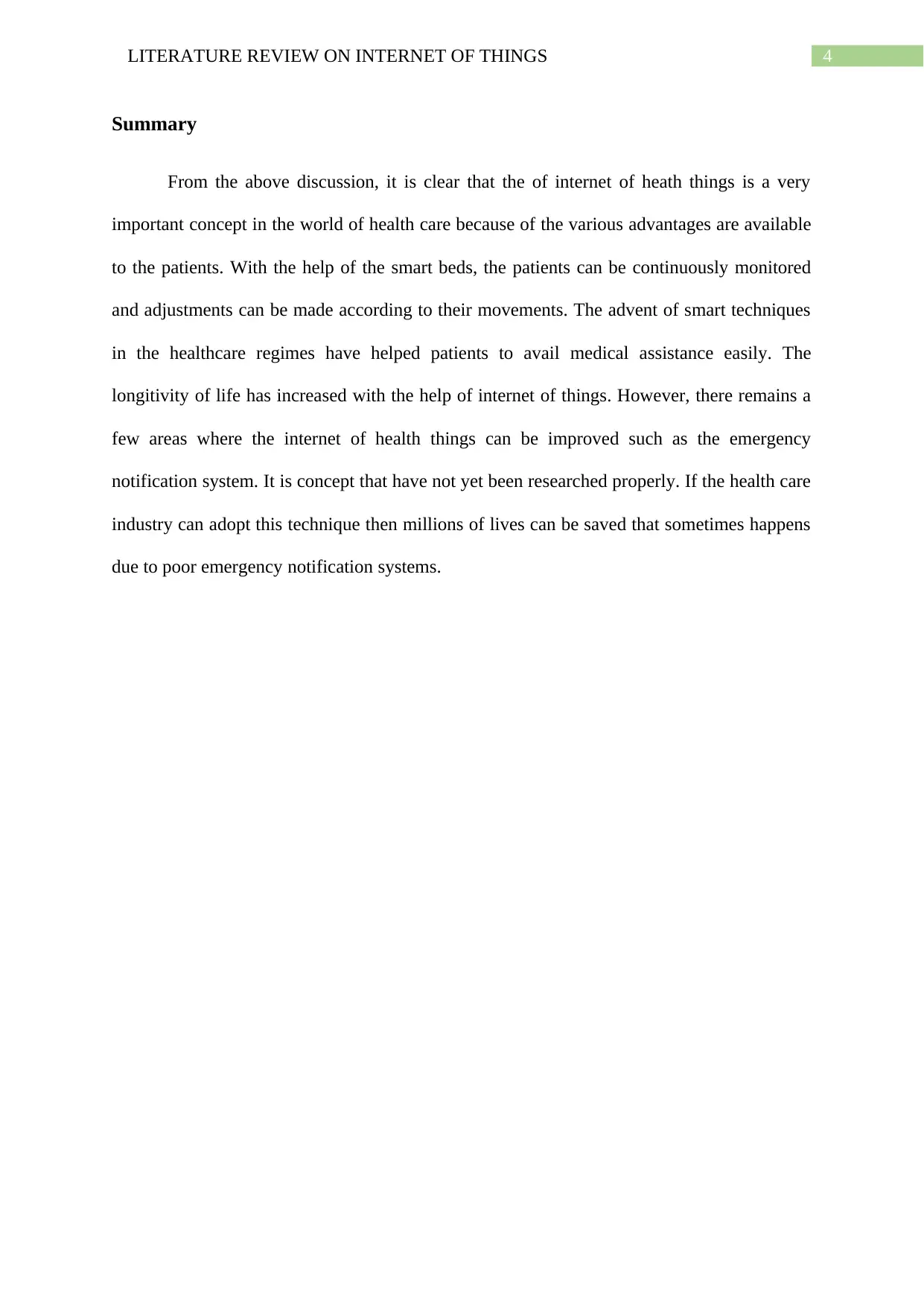
4LITERATURE REVIEW ON INTERNET OF THINGS
Summary
From the above discussion, it is clear that the of internet of heath things is a very
important concept in the world of health care because of the various advantages are available
to the patients. With the help of the smart beds, the patients can be continuously monitored
and adjustments can be made according to their movements. The advent of smart techniques
in the healthcare regimes have helped patients to avail medical assistance easily. The
longitivity of life has increased with the help of internet of things. However, there remains a
few areas where the internet of health things can be improved such as the emergency
notification system. It is concept that have not yet been researched properly. If the health care
industry can adopt this technique then millions of lives can be saved that sometimes happens
due to poor emergency notification systems.
Summary
From the above discussion, it is clear that the of internet of heath things is a very
important concept in the world of health care because of the various advantages are available
to the patients. With the help of the smart beds, the patients can be continuously monitored
and adjustments can be made according to their movements. The advent of smart techniques
in the healthcare regimes have helped patients to avail medical assistance easily. The
longitivity of life has increased with the help of internet of things. However, there remains a
few areas where the internet of health things can be improved such as the emergency
notification system. It is concept that have not yet been researched properly. If the health care
industry can adopt this technique then millions of lives can be saved that sometimes happens
due to poor emergency notification systems.
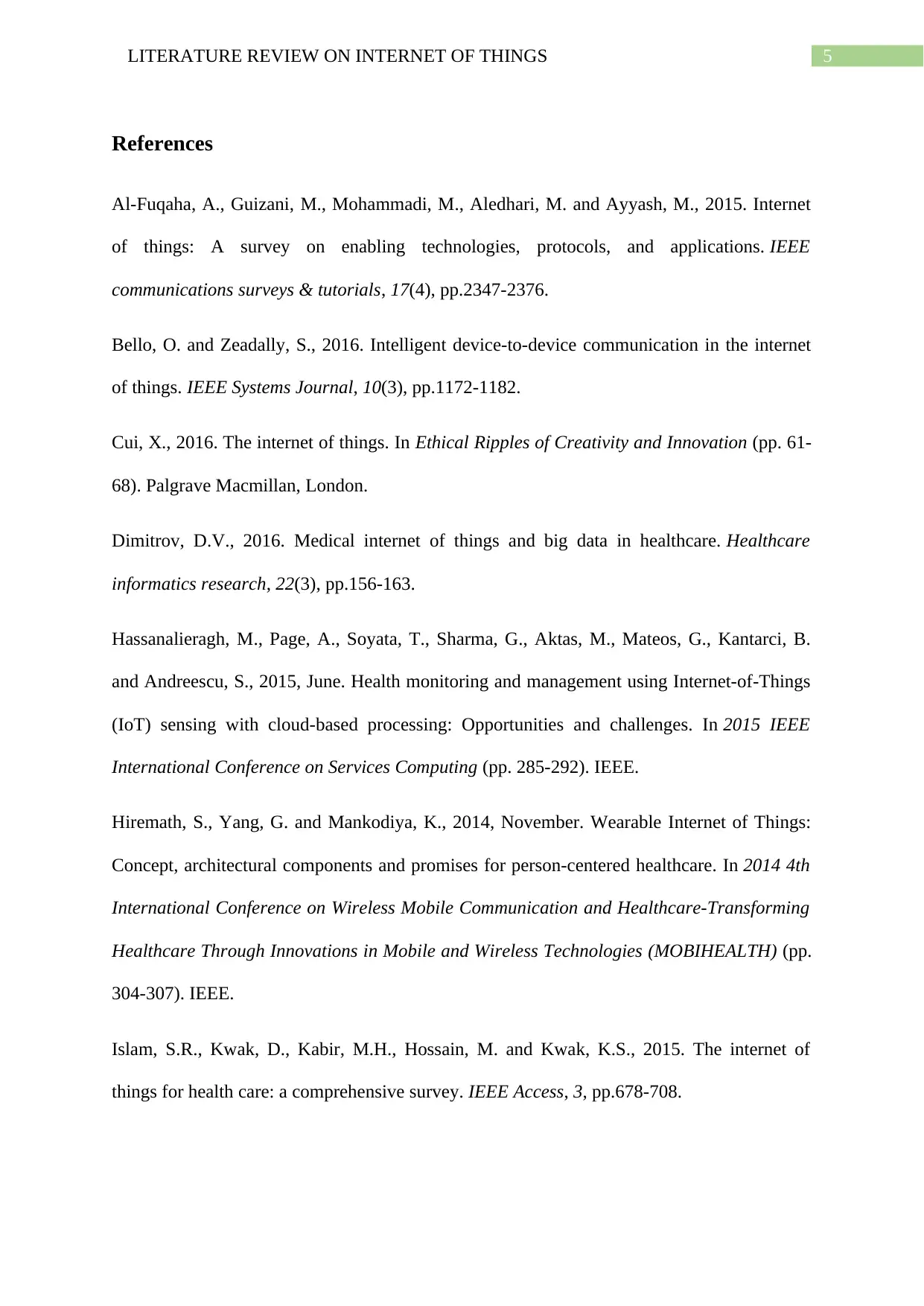
5LITERATURE REVIEW ON INTERNET OF THINGS
References
Al-Fuqaha, A., Guizani, M., Mohammadi, M., Aledhari, M. and Ayyash, M., 2015. Internet
of things: A survey on enabling technologies, protocols, and applications. IEEE
communications surveys & tutorials, 17(4), pp.2347-2376.
Bello, O. and Zeadally, S., 2016. Intelligent device-to-device communication in the internet
of things. IEEE Systems Journal, 10(3), pp.1172-1182.
Cui, X., 2016. The internet of things. In Ethical Ripples of Creativity and Innovation (pp. 61-
68). Palgrave Macmillan, London.
Dimitrov, D.V., 2016. Medical internet of things and big data in healthcare. Healthcare
informatics research, 22(3), pp.156-163.
Hassanalieragh, M., Page, A., Soyata, T., Sharma, G., Aktas, M., Mateos, G., Kantarci, B.
and Andreescu, S., 2015, June. Health monitoring and management using Internet-of-Things
(IoT) sensing with cloud-based processing: Opportunities and challenges. In 2015 IEEE
International Conference on Services Computing (pp. 285-292). IEEE.
Hiremath, S., Yang, G. and Mankodiya, K., 2014, November. Wearable Internet of Things:
Concept, architectural components and promises for person-centered healthcare. In 2014 4th
International Conference on Wireless Mobile Communication and Healthcare-Transforming
Healthcare Through Innovations in Mobile and Wireless Technologies (MOBIHEALTH) (pp.
304-307). IEEE.
Islam, S.R., Kwak, D., Kabir, M.H., Hossain, M. and Kwak, K.S., 2015. The internet of
things for health care: a comprehensive survey. IEEE Access, 3, pp.678-708.
References
Al-Fuqaha, A., Guizani, M., Mohammadi, M., Aledhari, M. and Ayyash, M., 2015. Internet
of things: A survey on enabling technologies, protocols, and applications. IEEE
communications surveys & tutorials, 17(4), pp.2347-2376.
Bello, O. and Zeadally, S., 2016. Intelligent device-to-device communication in the internet
of things. IEEE Systems Journal, 10(3), pp.1172-1182.
Cui, X., 2016. The internet of things. In Ethical Ripples of Creativity and Innovation (pp. 61-
68). Palgrave Macmillan, London.
Dimitrov, D.V., 2016. Medical internet of things and big data in healthcare. Healthcare
informatics research, 22(3), pp.156-163.
Hassanalieragh, M., Page, A., Soyata, T., Sharma, G., Aktas, M., Mateos, G., Kantarci, B.
and Andreescu, S., 2015, June. Health monitoring and management using Internet-of-Things
(IoT) sensing with cloud-based processing: Opportunities and challenges. In 2015 IEEE
International Conference on Services Computing (pp. 285-292). IEEE.
Hiremath, S., Yang, G. and Mankodiya, K., 2014, November. Wearable Internet of Things:
Concept, architectural components and promises for person-centered healthcare. In 2014 4th
International Conference on Wireless Mobile Communication and Healthcare-Transforming
Healthcare Through Innovations in Mobile and Wireless Technologies (MOBIHEALTH) (pp.
304-307). IEEE.
Islam, S.R., Kwak, D., Kabir, M.H., Hossain, M. and Kwak, K.S., 2015. The internet of
things for health care: a comprehensive survey. IEEE Access, 3, pp.678-708.
⊘ This is a preview!⊘
Do you want full access?
Subscribe today to unlock all pages.

Trusted by 1+ million students worldwide
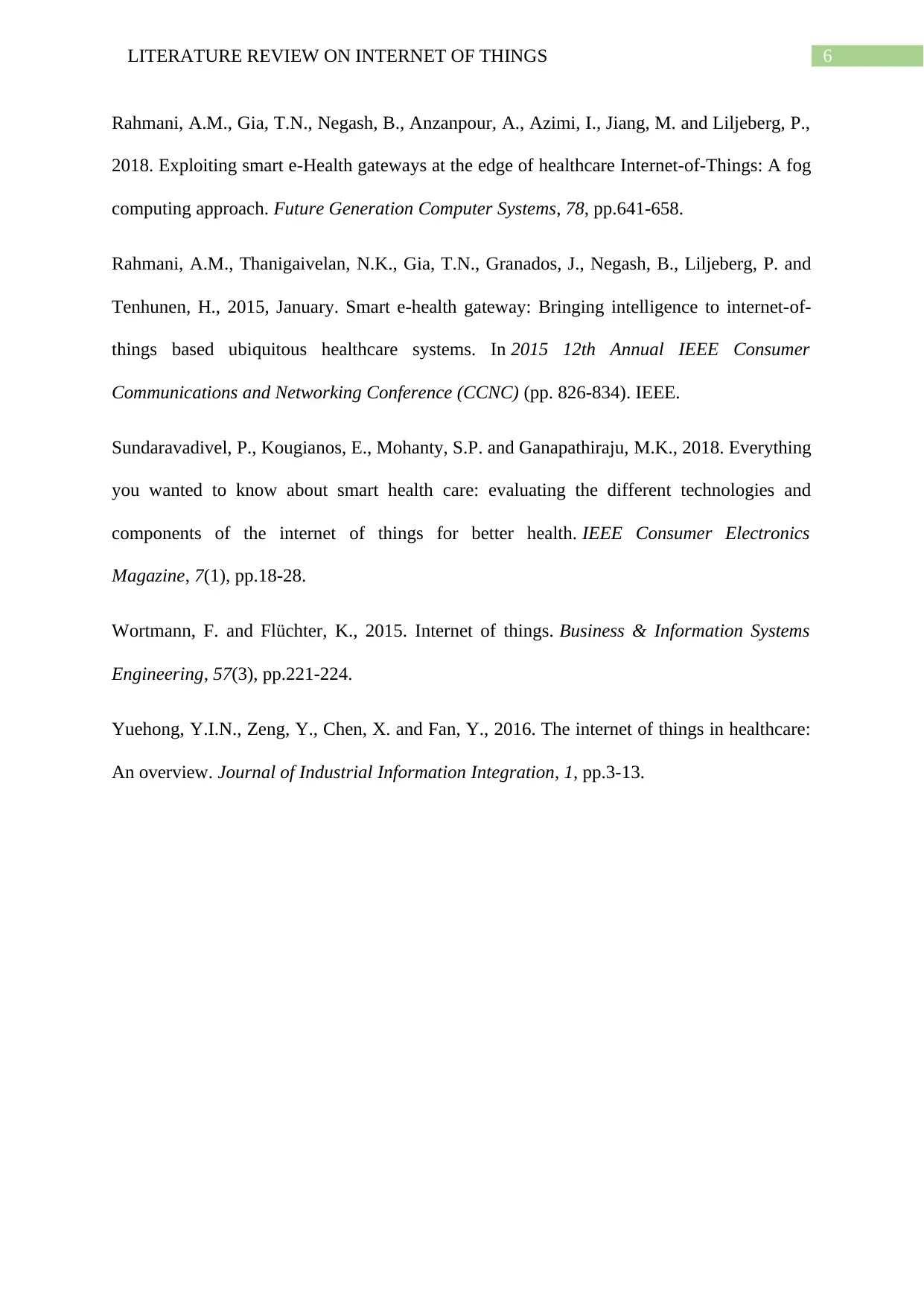
6LITERATURE REVIEW ON INTERNET OF THINGS
Rahmani, A.M., Gia, T.N., Negash, B., Anzanpour, A., Azimi, I., Jiang, M. and Liljeberg, P.,
2018. Exploiting smart e-Health gateways at the edge of healthcare Internet-of-Things: A fog
computing approach. Future Generation Computer Systems, 78, pp.641-658.
Rahmani, A.M., Thanigaivelan, N.K., Gia, T.N., Granados, J., Negash, B., Liljeberg, P. and
Tenhunen, H., 2015, January. Smart e-health gateway: Bringing intelligence to internet-of-
things based ubiquitous healthcare systems. In 2015 12th Annual IEEE Consumer
Communications and Networking Conference (CCNC) (pp. 826-834). IEEE.
Sundaravadivel, P., Kougianos, E., Mohanty, S.P. and Ganapathiraju, M.K., 2018. Everything
you wanted to know about smart health care: evaluating the different technologies and
components of the internet of things for better health. IEEE Consumer Electronics
Magazine, 7(1), pp.18-28.
Wortmann, F. and Flüchter, K., 2015. Internet of things. Business & Information Systems
Engineering, 57(3), pp.221-224.
Yuehong, Y.I.N., Zeng, Y., Chen, X. and Fan, Y., 2016. The internet of things in healthcare:
An overview. Journal of Industrial Information Integration, 1, pp.3-13.
Rahmani, A.M., Gia, T.N., Negash, B., Anzanpour, A., Azimi, I., Jiang, M. and Liljeberg, P.,
2018. Exploiting smart e-Health gateways at the edge of healthcare Internet-of-Things: A fog
computing approach. Future Generation Computer Systems, 78, pp.641-658.
Rahmani, A.M., Thanigaivelan, N.K., Gia, T.N., Granados, J., Negash, B., Liljeberg, P. and
Tenhunen, H., 2015, January. Smart e-health gateway: Bringing intelligence to internet-of-
things based ubiquitous healthcare systems. In 2015 12th Annual IEEE Consumer
Communications and Networking Conference (CCNC) (pp. 826-834). IEEE.
Sundaravadivel, P., Kougianos, E., Mohanty, S.P. and Ganapathiraju, M.K., 2018. Everything
you wanted to know about smart health care: evaluating the different technologies and
components of the internet of things for better health. IEEE Consumer Electronics
Magazine, 7(1), pp.18-28.
Wortmann, F. and Flüchter, K., 2015. Internet of things. Business & Information Systems
Engineering, 57(3), pp.221-224.
Yuehong, Y.I.N., Zeng, Y., Chen, X. and Fan, Y., 2016. The internet of things in healthcare:
An overview. Journal of Industrial Information Integration, 1, pp.3-13.
1 out of 7
Related Documents
Your All-in-One AI-Powered Toolkit for Academic Success.
+13062052269
info@desklib.com
Available 24*7 on WhatsApp / Email
![[object Object]](/_next/static/media/star-bottom.7253800d.svg)
Unlock your academic potential
Copyright © 2020–2025 A2Z Services. All Rights Reserved. Developed and managed by ZUCOL.



